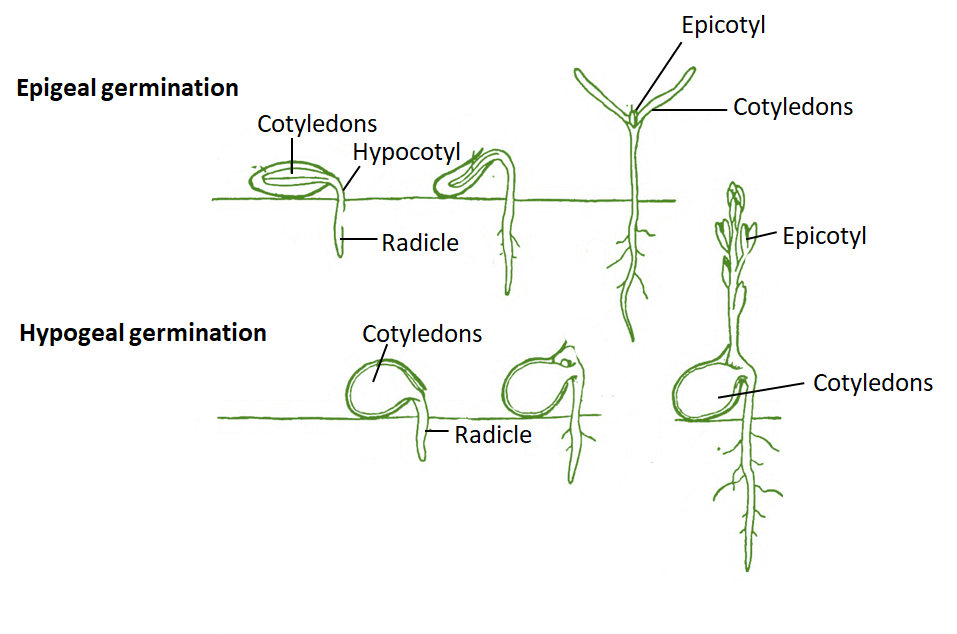
Write any two differences between Hypogeal germination and epigeal germination.
Answer
471.9k+ views
Hint: The term is applied to the sprouting of a seedling from a seed of an angiosperm or gymnosperm, the growth of sporting from a spore, for example, the spores of fungi, ferns, bacteria, and also the growth of the pollen tube from the pollen grain of a seed plant.
Complete step by step answer:

Additional Information:
Similarities Between Epigeal And Hypogeal Germination:
- Both are described by the relative position of the cotyledons to the soil during germination.
- Both are the two main methods of germination.
- In both methods water is an essential component.
- In the case of both Epigeal and hypogeal germination, the epicotyl is curved to reduce damage to the plumule.
Plumule of Hypogeal and epigeal germination:
- The plumule comes out of the seed coat by the elongation of the hypocotyl- Epigeal Germination.
- The plumule comes out of the seed coat by the elongation of epicotyl- Hypogeal Germination.
Note: Epigeal germination could be a kind of germination whereby the seed leaves or the cotyledons are brought on to the surface or above the soil while the shoot during germination. Hypogeal germination is a form of germination whereby the seed leaves or the cotyledons remain below the soil surface during germination.
Complete step by step answer:
| Hypogeal germination | Epigeal Germination: |
| In this kind of germination, the epicotyl elongates and becomes curved. It brings the plumule above the soil. | In this type of germination, hypocotyl grows actively and becomes curved. It brings the seed above the soil. |
| Cotyledons remain underground. | After coming above the surface of the soil, the hypocotyl straightens. |
| Example: pea, gram, etc. | Example: bean, groundnut. |

Additional Information:
Similarities Between Epigeal And Hypogeal Germination:
- Both are described by the relative position of the cotyledons to the soil during germination.
- Both are the two main methods of germination.
- In both methods water is an essential component.
- In the case of both Epigeal and hypogeal germination, the epicotyl is curved to reduce damage to the plumule.
Plumule of Hypogeal and epigeal germination:
- The plumule comes out of the seed coat by the elongation of the hypocotyl- Epigeal Germination.
- The plumule comes out of the seed coat by the elongation of epicotyl- Hypogeal Germination.
Note: Epigeal germination could be a kind of germination whereby the seed leaves or the cotyledons are brought on to the surface or above the soil while the shoot during germination. Hypogeal germination is a form of germination whereby the seed leaves or the cotyledons remain below the soil surface during germination.
Recently Updated Pages
Basicity of sulphurous acid and sulphuric acid are

Master Class 12 Economics: Engaging Questions & Answers for Success

Master Class 12 Maths: Engaging Questions & Answers for Success

Master Class 12 Biology: Engaging Questions & Answers for Success

Master Class 12 Physics: Engaging Questions & Answers for Success

Master Class 12 Business Studies: Engaging Questions & Answers for Success

Trending doubts
Which are the Top 10 Largest Countries of the World?

Draw a labelled sketch of the human eye class 12 physics CBSE

Differentiate between homogeneous and heterogeneous class 12 chemistry CBSE

What is a transformer Explain the principle construction class 12 physics CBSE

What are the major means of transport Explain each class 12 social science CBSE

What is the Full Form of PVC, PET, HDPE, LDPE, PP and PS ?




